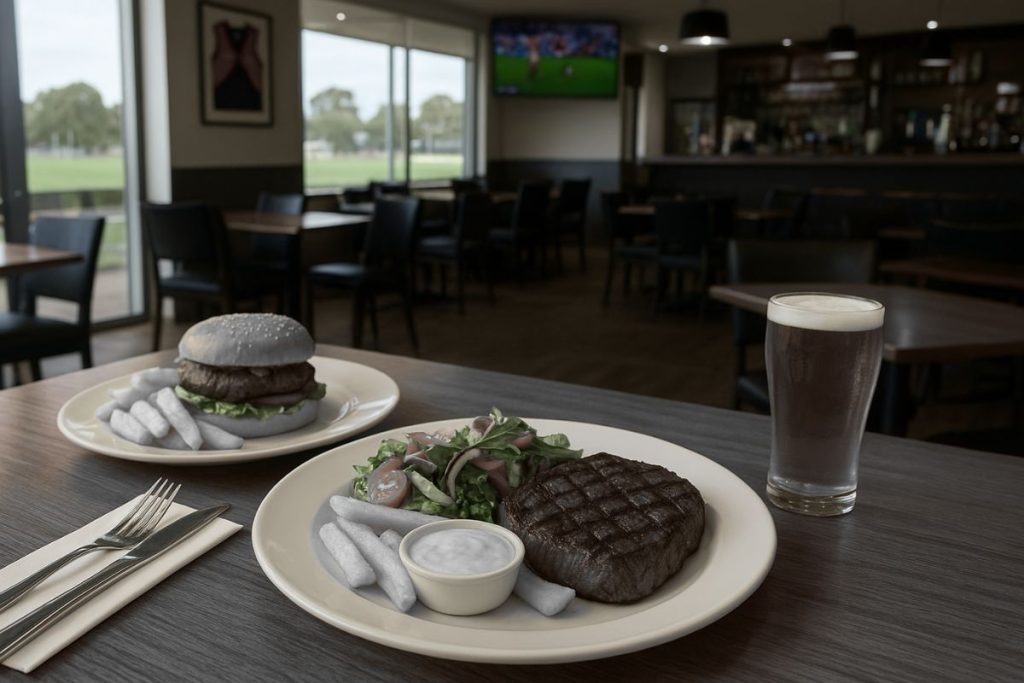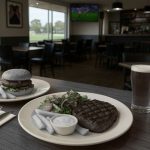A football club menu is the food-and-drink offering served in a club’s bar, bistro or restaurant to its members and guests. These menus often combine pub-style comfort foods (burgers, steaks, pizzas) with healthier or international dishes to satisfy players and fans alike. In essence, club menus reflect the local culture and the club’s identity for example, Australian clubs offer classic bistro fare, while overseas clubs may feature regional specialties.
A well-curated menu enhances the social atmosphere at the club: members relax over a meal when watching a game or celebrating together. This guide covers key aspects of football club menus, from common menu items and trends to examples from various clubs (Ainslie, West Adelaide, Aldinga, Aspley, Athelstone and even Portugal’s Guindalense FC). We’ll also include useful statistics, internal links to club pages, and a FAQs section to ensure a thorough understanding.
Key Components of a Football Club Menu
A typical football club menu balances hearty pub food with lighter and locally-inspired options. Clubs aim to please diverse tastes – from hungry players refueling after matches to families dining out. Common menu features include:
-
Grilled and Barbecue Items: Many club menus boast protein-rich dishes like chargrilled steaks, schnitzels, chicken wings or ribs. For example, Athelstone FC’s bistro (Arturo’s @ Raggies) offers crumbed chicken/veal schnitzel, beef burgers and Scotch fillet steaks. These high-protein entrées support active club members.
-
Classic Pub Fare: Burgers, pizzas, and fish-and-chips are staples. West Adelaide FC’s Westies Bar & Bistro menu features items like grilled chicken burgers, vegetarian burgers, and a variety of pizzas. Such comfort foods are popular with regulars and visitors.
-
International and Fusion Dishes: To stand out, clubs may incorporate global flavors. Ainslie FC’s Limestone Bistro, for example, serves Asian-inspired mains and fusion dishes alongside Australian favorites. This diversity appeals to younger members and foodies.
-
Healthy and Vegetarian Options: Modern club menus include salads, grilled fish, and vegetarian plates. Notably, Westies Bar & Bistro “released a new bistro menu that features… Vegetarian options” in 2024. Similarly, Aspley Hornets’ menu highlights fresh seafood and salads, catering to health-conscious patrons.
-
Family and Kids’ Selections: Clubs are community hubs, so children’s menus and family combos are common. Athelstone’s menu explicitly includes “children’s meals”. This means simple options (mini-burgers, pasta) at lower prices, encouraging families to dine at the club.
-
Seasonal & Special Menus: Many clubs run special menus for holidays or events. For example, the Ainslie Football Club Canberra Christmas menu (Xmas Day Lunch) is a fixed three-course festive meal for members and guests. Seasonal game-day specials and set menus also boost traffic.
Across the board, a football club menu emphasizes variety and affordability. Dishes are typically priced for member budgets, and “club favourites” (classic meat pies, grilled sausages, etc.) are staples. Clubs often display menus online for transparency and to attract visitors. (For instance, the Westies Bar & Bistro at West Adelaide FC publishes its bistro menu for public viewing.)
Popular Football Club Menus by Club
Let’s look at examples of club menus that illustrate these principles:
-
Ainslie Football Club Menu (Canberra): The Ainslie Football and Social Club (Ainslie Group) offers a modern, extensive menu. The club’s brasserie and bar serve 46 dishes ranging from chargrilled steaks and schnitzels to Asian curries. Lunch and dinner services run daily (open from 12pm–2pm & 5:30pm–8:30pm). Club favourites include share plates and gourmet pizzas alongside café items like barista-made coffee. Ainslie also runs special menus: for example, the Ainslie Football Club Canberra Christmas menu (Xmas Day Lunch) is a set 3-course festive meal for members and guests, complete with wine. (Member prices are $85, kids $25.) Overall, the Ainslie Football and Social Club menu emphasizes variety and event-driven specials.
-
West Adelaide Football Club Menu (Adelaide): The Westies Bar & Bistro at West Adelaide FC (a SANFL club) is open daily to the public. Its menu features classic pub fare: burgers, schnitzels, sandwiches and pizzas. In late 2024, Westies “released their new bistro menu that features new food offerings and Vegetarian options”, showing a commitment to menu refreshment. (For example, the burgers section now includes a plant-based vegetarian burger.) The Westies menu caters to match-day crowds and families, with hearty mains and side dishes.
-
Aldinga Football Club Menu (SA): Aldinga FC runs the Sharks Bar & Bistro in their clubrooms. The Sharks Bar provides regular dine-in and takeaway meals, open Thursdays through Saturdays. Its offerings include typical club staples (parmas, burgers, pizzas) and function catering. As the Aldinga site notes, it “provides regular meals for dine-in, take away & private functions”. Members and community groups can reserve tables, making the club menu a community dining hub.
-
Aspley Hornets Football Club Menu (Brisbane): Aspley Hornets boasts multiple dining venues: the Hornets Bistro and the 6 Points Café. The Hornets Bistro “offers a relaxed atmosphere” and a menu ranging “from light snacks through to a steak”. In practice, this means dishes like chicken parmigiana, salads, pasta and BBQ meats made from fresh local produce. The separate 6 Points Café focuses on lunches and casual fare – offering sandwiches, burgers and salads daily. Overall, the Aspley Hornets Football Club menu highlights fresh ingredients and value (e.g. lunch specials from $15 for members).
-
Athelstone Football Club Menu (Adelaide): At Athelstone FC (nicknamed the Raggies), the onsite bistro is called Arturo’s @ Raggies. Its menu is Italian-Australian in flavor. Appetizers include bruschetta and arancini; mains feature Schnitzel (chicken/beef), the Raggies Beef Burger ($24), lasagna ($24), and pasta (Rigatoni/Spaghetti $22). There’s also a grill section: 350g Scotch Fillet steaks ($37), Surf & Turf, a Mediterranean chicken/prawn plate, and even prawn skewers. Kids are catered for with a “Bambini” menu (nuggets, penne, cheeseburgers). In short, the Athelstone Football Club menu offers both hearty steaks and family-friendly meals. (The bistro opens Thurs–Sat nights and posts its menu online.)
-
Guindalense Football Club Menu (Porto, Portugal): (International example) The Guindalense Futebol Clube in Porto turned its ground into a popular food venue. Its menu features Portuguese classics: large francesinha sandwiches (stacked meats/cheese in spicy sauce), bifana (pork) and grilled chouriço (sausage), as well as pizzas and burgers. (Travelers note the huge portions and riverside terrace atmosphere.) This shows how a club menu abroad reflects local tastes – in this case, hearty Portuguese bar snacks and hearty sandwiches.
These examples illustrate the range of offerings: from Australian pub cuisine to European specialties. Most club menus share common traits (grilled proteins, pizzas, salads), but each club tailors its menu to members’ preferences and events.
Football fans celebrating a goal at a club bar – showcasing the lively atmosphere where football club menus are enjoyed.
The atmosphere at a football club is social and celebratory. Fans gather around TV screens or heaters (“indoor fireside or outdoor terrace” as one Canberra club describes) to enjoy meals and drinks. Club menus therefore often include shareable snacks (finger food, platters) and all-day menus to support both casual visits and game-day parties. For example, clubs advertise “Happy Hour” specials or game-day combo meals to draw supporters. Engaging décor and live sports broadcasts enhance the dining experience – which in turn boosts time on page as readers visualize the scene. (Ready to watch the game? Visit the Westies Bar & Bistro or Aldinga Sharks Bar on their websites to see current menus.)
Crafting a Winning Football Club Menu:
Designing an effective club menu involves strategic choices. Here are best practices:
-
Understand Your Audience: Survey members’ tastes. A suburban community club may need kid-friendly burgers and affordable grills, while a city club might include gourmet salads and cocktails. (The Ainslie FC menu, for instance, spans casual café fare to fine dining at Limestone Bistro.)
-
Balance Nutrition and Indulgence: Players need protein and carbs (steaks, chicken, pasta) for recovery, but fans enjoy comfort food (fried appetizers, pizzas). Include vegetarian/vegan and gluten-free dishes for inclusivity.
-
Seasonal & Themed Specials: Rotate specials for big games or holidays. Christmas in July events, Father’s Day feasts, or themed match menus (e.g. “The Derby Double-Cheese Burger”). Advertising a Christmas Day Lunch menu (like Ainslie does) attracts bookings early.
-
Menu Layout & Highlighting: Use clear sections (Starters, Mains, Kids, Drinks). Feature club signatures (e.g. “Raggies Beef Burger” or “Sharks Fish & Chips”) prominently. Descriptions should sound enticing (mention local produce or chef names if notable).
-
Pricing & Loyalty: Offer member discounts, combo deals (meal + drink), and loyalty points. For example, Aspley Hornets gives members lunch specials from $15. Keeping prices reasonable encourages repeat visits.
-
Quality & Presentation: Fresh, well-prepared food builds reputation. Many clubs emphasize “top-notch dining” or “best fresh produce”. Attractive plating and a clean venue increase dwell time and word-of-mouth.
By following on-page SEO practices, clubs also optimize their menu pages for search: using keyword-rich descriptions, images, and structured data (e.g. menu schemas). Including a meta description and alt text helps online visibility. (See the meta tags below for an example of SEO best practice.)
FAQs about Football Club Menus
Q: What kind of food is on a typical football club menu?
A: Generally, expect classic pub and bistro fare: grilled meats (steak, chicken, schnitzel), burgers, pizzas, fries, and salads. Clubs often include local specialties or chef’s creations (e.g. Athelstone FC’s lasagna or Aspley Hornets’ seafood). Healthy salads and wraps are common too, especially in modern menus. Many clubs also offer kids’ meals and a range of beverages (beer, soft drinks, coffee) to cater to all ages.
Q: Are football club menus open to non-members?
A: It depends on the club. Some club bistros (like Westies Bar & Bistro at West Adelaide) are open to the public, serving anyone who walks in. Others may restrict certain areas to members only. However, many clubs welcome guests during lunch/dinner hours and on match days. Always check the club’s website or Facebook (see Aldinga Sharks Bistro{target=_blank}) for access rules and hours.
Q: How much do club menu meals usually cost?
A: Club menus tend to be affordable. Typical mains range from $15–$30. For example, burgers and pastas at Athelstone FC are around $22–$26. Members often get discounted pricing (Aspley Hornets offers $15 lunch specials to members). Special event menus (like Christmas lunch) have fixed prices ($85 at Ainslie FC). Overall, expect midrange pricing similar to casual restaurants.
Q: Can I see a club’s menu online?
A: Yes, many clubs post menus on their websites. For example, the Ainslie Group publishes PDF menus for Limestone Bistro. The West Adelaide FC site links to a “New Bistro Menu” PDF. You can also find menus on event booking pages (e.g. Ainslie Xmas lunch event{target=_blank}). For up-to-date info, visit the club’s official page or social media. Links: Westies Bistro , Aldinga Sharks , Aspley Hornets Bistro , Athelstone Raggies .
Q: What makes a football club menu different from a regular restaurant menu?
A: Club menus focus on community atmosphere. You’ll often find nods to the club or local area in dish names. There may be game-day meal deals and many screens for watching sports while you eat. Clubs also host functions (weddings, team dinners), so menus might include banquet or BBQ packages. In short, club menus combine casual dining with a friendly, club-centric vibe.
Conclusion & Engagement
A well-designed football club menu is more than just food – it’s a key part of a club’s community appeal and identity. The examples above show how clubs from Canberra to Porto tailor their menus to member needs, local tastes, and special occasions. By offering variety (from affordable family meals to special event dinners), clubs keep members engaged and attract visitors. Remember to incorporate current SEO practices: use keyword-rich titles, meta descriptions, and alt text (e.g. “Ainslie Football Club lunch menu – steaks and salads”) on your menu pages.
Read Previous Post: Zoysia grass seed


